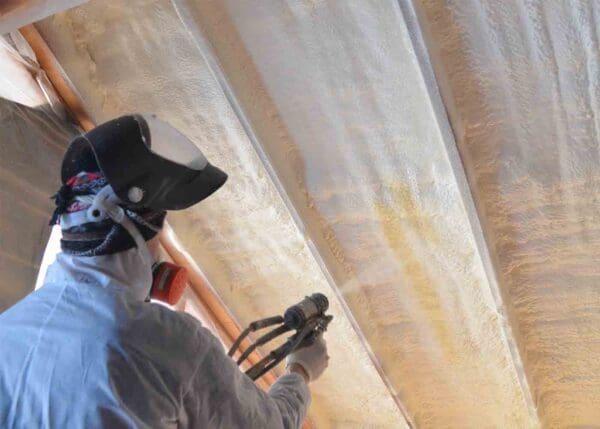01. Asbestos Use in Fireproofing Materials
Why Was Asbestos Used in Fireproofing Materials?
For decades, homes, buildings and machinery were constructed with asbestos fireproofing materials. In the mid-1800s, modern asbestos fireproofing products became widely used in the United States.
Asbestos fireproofing materials were added to homes and buildings to decrease the possibility of a fire. Some fireproofing materials were made of 5 – 30% asbestos fibers.
Asbestos was also woven into textiles such as fireproof clothing and blankets. Asbestos clothing was often worn by workers as a protection against hot machinery.
Asbestos Fireproofing Materials History at a Glance
- Years of Manufacture: 1800s – Present
- Military Use: Air Force, Army, Coast Guard, Marines, Navy
- Places Used: Clothing, drywall, flooring, insulation, roofing
- Asbestos Use Banned: No
- Noteworthy Brands: A.P. Green Industries, Johns-Manville, Turner & Newall, W.R. Grace
The use of asbestos fireproofing products increased until the 1970s. From 1960 to 1969, more than 40,000 tons of fireproofing materials were sprayed annually in U.S. high-rise buildings.
In the 1970s, asbestos laws and regulations began limiting the use of asbestos fireproofing products. Federal organizations such as the U.S. Environmental Protection Agency (EPA) and the Occupational Safety and Health Administration (OSHA) limit uses today. However, not all uses of asbestos are banned in the U.S. Up to 1% of asbestos may still be added to certain fireproofing materials.
As a result, individuals may still risk asbestos exposure from old asbestos fireproofing materials and some current fire-resistant products.
Dangers of Asbestos in Fireproofing Materials
Asbestos fireproofing materials were meant to protect individuals from high heat or fire. However, asbestos materials create a unique health hazard. Asbestos fibers may be released into the air if these fireproofing materials are disturbed.
In 1983, researchers studied fireproofing insulation materials sprayed on 127 building ceilings throughout the U.S. Asbestos was found in more than 50% of the buildings. During dry removal of the materials, workers were exposed to extremely high concentrations of asbestos.
If airborne asbestos is inhaled, it may lead to an asbestos-related disease such as asbestosis, lung cancer or mesothelioma.
02. List of Asbestos Fireproofing Materials
Asbestos Fireproofing Product List
For decades, a variety of fireproofing materials were made with asbestos. Some fireproofing products may still contain small amounts of asbestos. Individuals who handle these materials may risk exposure.
Many fireproofing materials were frequently used in construction. Asbestos fireproofing materials used in the construction industry include:
- Asbestos boards
- Asbestos fireproofing sprays
- Asbestos helmets
- Ceiling tiles
- Firebrick
- Fire doors
- Fireproofing materials
- Floor tiles
- Magnesia
- Paint
- Refractory products
- Roof shingles
Outside of construction, fireproof textile products were also widely used in a number of industries. These products were meant to protect workers and other individuals from hot machinery and fires. Fireproof textile products made with asbestos includes:
- Asbestos fire blankets
- Asbestos cloth
- Asbestos cords
- Asbestos curtains
- Asbestos yarn
- Coveralls
- Gloves, mitts and mittens
If asbestos-containing materials are found in a home or building, individuals should contact an abatement professional. If done incorrectly, asbestos removal can be dangerous.
Many negligent companies were responsible for manufacturing asbestos products. Individuals exposed to asbestos from a company’s product may file a mesothelioma lawsuit.
03. Fireproofing Materials & Asbestos Exposure
Who Is at Risk of Asbestos Exposure From Fireproofing Materials?
Workers in several industries may be at risk of exposure from asbestos fireproofing materials. Individuals who worked in areas of high temperature and pressure often handled fireproofing products.
During installation, maintenance or repair these materials may become disturbed. Airborne asbestos creates a health risk for all workers in the area. If asbestos fibers are inhaled, workers risk developing an asbestos illness.
People living in a home or building constructed with asbestos fireproofing materials may also be at risk. As construction materials age, they may become friable and create an airborne asbestos risk.
04. Asbestos Lawsuits
Asbestos Lawsuits, Settlements & Other Compensation
Individuals exposed to an asbestos fireproofing product may seek financial compensation. To receive compensation, asbestos exposure victims may file:
Some individuals may also file an asbestos trust fund claim. Companies that face a large number of mesothelioma lawsuits may establish a trust fund to compensate asbestos victims.
Several companies that manufactured fireproofing materials have established asbestos trusts. Notable asbestos companies with trust funds include:
- Armstrong World Industries
- Combustion Engineering
- Harbison-Walker Refractories Company
- Johns-Manville
- The Flintkote Company
- U.S. Gypsum Company
- W.R. Grace
Many asbestos exposure victims and their families have received mesothelioma settlements and awards. Compensation from a claim or lawsuit may help mesothelioma patients pay for treatment and other expenses.
Former Millwright Awarded $2 Million in Mesothelioma Lawsuit
In 1999, a retired millwright was diagnosed with mesothelioma. During his career, the man worked for Kaiser Aluminum and Dow Chemical Company. At these facilities, the man came in contact with asbestos cement, fireproofing spray and pipe covering.
The retired millwright and his wife filed an asbestos lawsuit against his employers and several asbestos manufacturers. The jury awarded the plaintiffs:
- $2,000,000 in general damages
- $125,000 in medical damages
The man’s wife was also awarded $125,000 for loss of consortium.
Individuals who developed an asbestos-related disease may contact a mesothelioma law firm. Experienced asbestos attorneys may help victims and their loved ones receive compensation.





